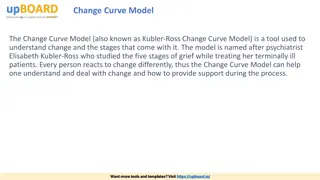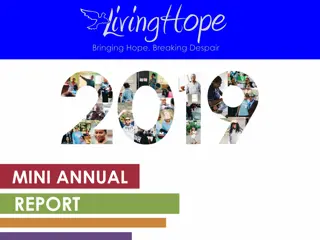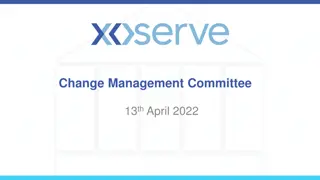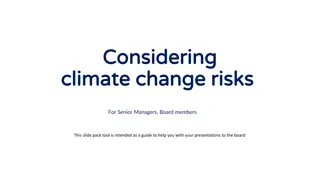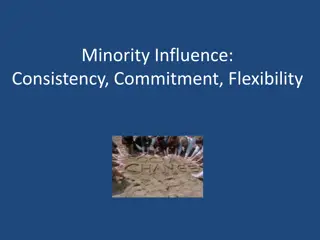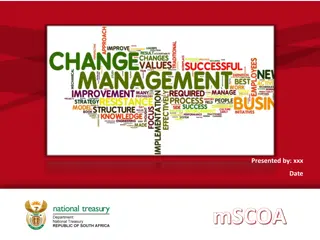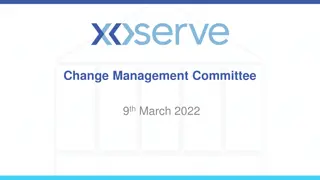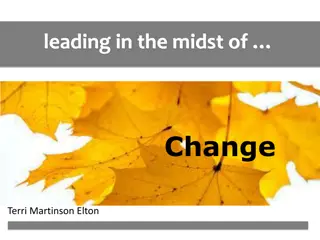Leading Change and Bringing Others Along
In this collection of insights, you will explore the dynamics of change management, resistance to change, the Küber-Ross Change Curve, brain barriers to change, and strategies for effective performance measurement. Learn from experts like Kotter and Cohen about the challenges and core patterns of successful change initiatives.
Download Presentation

Please find below an Image/Link to download the presentation.
The content on the website is provided AS IS for your information and personal use only. It may not be sold, licensed, or shared on other websites without obtaining consent from the author.If you encounter any issues during the download, it is possible that the publisher has removed the file from their server.
You are allowed to download the files provided on this website for personal or commercial use, subject to the condition that they are used lawfully. All files are the property of their respective owners.
The content on the website is provided AS IS for your information and personal use only. It may not be sold, licensed, or shared on other websites without obtaining consent from the author.
E N D
Presentation Transcript
Leading Change and Bringing Others Along Pamela L. Eddy, William & Mary Faculty Change Agents Workshop, June 2017
What if we dont change at all. and something magical just happens?
Kotter and Cohen believe that the single biggest challenge in the change process is changing people s behavior. Core pattern associated with successful change: See (offer compelling data that grabs attention) Feel (foster an environment where there is buy-in) Change (institutionalize the initiative) (2002). The heart of change
Resistance to Change Individual Level Fear of unknown New learning Disruption of existing relationships Doing new things poorly Organizational Level Threats to power Inertia in organizational structure System relationships Sunk costs & Investments
The Kbler-Ross Change Curve Integration Changes integrated, renewed individual Denial Disbelief, looking for evidence that it isn t true Morale and competence Decision Learning how to work in new situation Frustration Recognition that things are different, anger Shock Surprise or shock at the event Experiment Initial engagement with new situation Depression Low mood, lacking in energy Time
Brain Barriers Failure to See Conceiving Failure to Move Believing Failure to Finish Achieving If you want others to change, you need to demonstrate your own willingness and ability to change. Black and Gregersen, 2002, p. 137
Performance Dashboard Conceiving Believing Achieving 1. Identify key elements to measure. 2. Establish how key elements will be measured. 3. Establish how often the measures will be taken. 4. Establish a baseline of performance. 5. Establish target performance levels. Black and Gregersen, p. 171.
Structural Human Resources Family Political Symbolic Factory or machine Jungle Carnival, temple theatre Metaphor for Organization Rules, roles, goals, policies, technology, environment Needs, skills, relationships Power, conflict, competition, organizational policies Culture, meaning, metaphor, ritual, ceremony, stories, heroes Central Concepts Social architecture Attune structure to task, technology, environment Excellence Empowerment Advocacy Inspiration Image of Leadership Basic Leadership Challenge Align organizational and human needs Develop agenda and power base Create belief, beauty meaning Caring Justice Belief Organizational Ethic
Reframing Change Structural Human Resources Anxiety, uncertainty; people feel incompetent and needy Political Symbolic Loss of direction, clarity, and stability; confusion, chaos Disempowerment; conflict between winners and losers Loss of meaning and purpose; clinging to the past Barriers to Change Communicating, realigning, & renegotiating formal patterns and polices Training to develop new skills; participation & involvement; psychological support Developing arenas where issues can be renegotiated and new coalitions formed Creating transition rituals; mourn the past, celebrate the future Essential Strategies Bolman & Deal, 2013, p. 378
Practice ScenariosStep One Step One: High Frame Groups (Blue number) Imagine the person you are trying to convince is coming from your same frame, what strategies for change would you use? You do not have to limit yourself to one strategy.
Practice ScenariosStep Two Step Two: Jigsaw (Green letter) What changes in your team s strategy by using multiple frames? How do you understand your own framing preferences now?
Lessons LearnedReflective Questions What strategies did you pick up in your discussion with others? How can you apply these ideas within your department? On your campus? With administrators? How does this relate to your experiences on campus?
Critical Reflection In what ways do you understand more about the range of frames and how you can apply them in your practice? In moving ahead, how are you going to use the strategies you learned with your colleagues and administrators? What strategies can you now apply in response to resistance to change? As you think about your action plan, what strategies might you employ? In order to reach my colleagues in the regional workshops, I will now . In working on our action plan, I will employ the following strategies .







